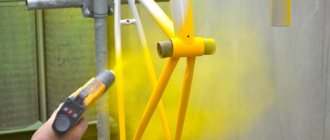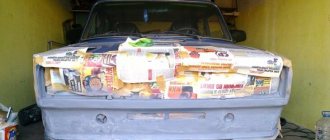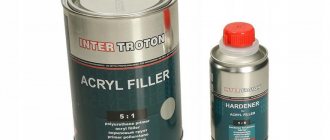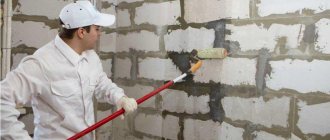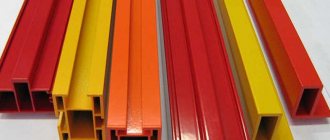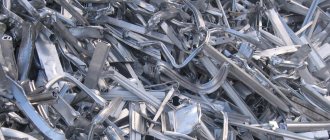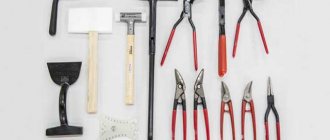Priming is a preparatory stage before painting metal surfaces, during which they are treated with a special composition that protects them from external influences and accelerates drying. However, the products to be painted are not always in ideal condition; in particular, they may be affected by corrosion.
In this case, a rust primer will help: this substance is applied to the part without preliminary cleaning. There are many types of these products, differing in composition, country of production, properties and price.
Types of primers for metal
Classification of such products is possible according to several criteria, including the form of release: paints, enamels and varnishes are distinguished. Based on the base substance, there are oil-based primers, water-based products and combined types. In addition, they are divided according to their properties into the following groups:
- Passivators. The composition of substances in this group includes salts of chromic acid, which protect the metal surface from oxidation. Typically, such primers are used for structures that are constantly in contact with water.
- Protectors. After application, a high-strength film appears on the metal being processed, as a result of which the coating becomes resistant to external influences, including contact with aggressive chemicals, salts, and acids.
- Insulators. They are based on lead white and prevent contact of the metal surface with water and oxygen. Such substances are usually used for structures used in the open air.
- Two-component based on phosphoric acid and passivators. They are versatile and suitable even for galvanized metal structures. The use of two-component converters makes it possible to reduce the consumption of paints and varnishes during subsequent processing, while the protective qualities are only enhanced.
- Inhibitors. After application, a protective coating is formed on the surface, which has the properties of a primer and enamel.
- Primers-converters for metal and rust for outdoor use. They are applied to products that have already suffered from corrosion stains; the orthophosphoric acid included in the composition promotes the formation of a film of iron phosphate. The affected areas undergo a partial restoration procedure.
Composition and technical characteristics
The main components that make up a rust primer:
- Solvent.
- A substance that serves as a binding element.
- Plasticizers to improve adhesion, effectiveness of metal surface protection, etc.
- Coloring pigment.
The characteristics of primers, including products applied to rust, depend on the components. The main qualities of such substances are conditional viscosity, the proportion of non-volatile ingredients, bending elasticity, impact resistance, hardness, adhesion in points, resistance to temperature changes.
Consumption per 1 m2
This indicator depends on the condition of the metal part to be processed, the number of corrosion spots, the depth of rust damage and other nuances. Average primer consumption for metal against rust:
- Primary priming, with the exception of compositions based on epoxy resin - 150-350 ml per square meter.
- Treatment with a rust primer based on epoxy or alkyd resin - 110-160 g per square.
- Using a universal composition – 80-140 ml per meter of surface.
Important! The indicated figures may vary, so when calculating the amount of substance for surface treatment, it is better to round the result up. Buying a rust primer with a reserve will allow you to avoid an unpleasant situation when there is not enough product in the midst of processing.
What kind of soil mixture is needed?
There are many types of metal alloys. For maximum effect when processing them, you need to choose your own mixture.
- For ferrous materials, such as cast iron, some alloys based on iron and steel, compounds are needed that slow down the corrosion process. After all, such materials are highly susceptible to this effect. In addition, primers provide better adhesion during final painting.
- For non-ferrous materials, such as aluminum, copper, brass, zinc, a primer is necessary only to ensure high-quality adhesion of the coating to the base. These same types of mixed primers are used for processing galvanized iron and steel.
- For galvanized ones, compositions based on organic solvents are well suited; they have also worked well when processing bases made of non-ferrous alloys.
- Black, already bearing traces of rust and corrosion, must be treated with a rust converter, which, through a chemical reaction, turns it into a durable film that can partially restore the damaged coating. Working with this composition does not require thorough pre-cleaning before application - it is enough to simply remove all surface contaminants.
- A special group includes special anti-stain building mixtures for surfaces that do not absorb moisture. They block various contaminants (soot, grease and others) when there is no way to clean them. If this is not done, then in the near future the stains will “appear” after painting.
A primer for metal used for external work must be selected in accordance with the climatic conditions of the region, and for internal work, it must take into account the operating conditions and the level of toxicity, especially when working in residential premises.
Operating principle
The anti-corrosion effect of such products is achieved due to the fact that they contain a rust converter; as a rule, this is orthophosphoric acid. When processed, it acts on corrosive stains, turning them into a non-oxidizing substance. After this, a film is formed on the rusty metal, which has good adhesion parameters and the same thickness. As a result, no visible traces of rust remain on the surface, and the paint and varnish materials do not peel off after application.
The use of reactive primers is especially important if it is necessary to process joints, internal corners, and other hard-to-reach parts of the workpiece or structure. Regardless of the composition, such substances include active components that improve fluidity and make penetration much greater. However, modern formulations are effective against medium-sized rust spots. Products from this group can be used for processing galvanized steel and plain metal.
Important! The principle of action of corrosion primers is to transform stains and create a protective shell, however, if there is loose, crumbling rust, it will still have to be removed mechanically.
The feasibility of purchasing a primer
The primer for metal surfaces contains inhibitors. Their function in this case is the maximum delay or suppression of physical and chemical processes, i.e. development of corrosion. The influence of moisture and oxygen usually becomes the main reason, requiring advance protection of metal structures from imminent destruction. Any surface is susceptible to negative external influences, except when properly treated. Application of any type of primer guarantees the transformation of the emulsion composition into a colorless film that protects the product. This process must precede the finishing decorative treatment of the surface. Its main tasks are: · ensuring adhesion between external metal surfaces and finishing. Thanks to priming, the decorative material will not delaminate or crumble; · antiseptic treatment. The primer contains substances that inhibit fungus and mold; · corrosion protection. The primer prevents the appearance of rust; · reducing the consumption of decorative coatings. Metal primer for exterior work must be chosen wisely, which will reduce its consumption and obtain the expected high-quality result. It can safely be called an indispensable basis for decorative finishing, a budget-friendly way to protect metal from corrosion.
Types of primers for rust
Classification of products is possible according to several criteria, from the type of metal and processing conditions to the period of hardening. The scope of application and effectiveness of such compositions depends on this.
By composition
Depending on the base, substances can be oily, aqueous or a combination. Based on their structure, they are divided into paints, enamels and varnishes. The composition also allows you to classify products according to additional criteria:
- Scope of use (indoors, outdoors).
- Hazard class (if the rust primer contains toxic substances, it is prohibited to use it on indoor surfaces).
- Substance consumption per meter of area.
By properties
According to the method of action, primers are classified as passivating, phosphating, isolates, converters and protectors. As for compositions intended to influence corrosion, the following varieties are distinguished:
- Primary composition. Its effect is the transformation of oxidized fragments into a protective shell.
- 2 in 1 – a product that combines the properties of the filler and the primary substance.
- The 3 in 1 rust primer is similar to the previous type, but also has the qualities of a final coating composition. It is its use that provides the greatest effect.
Varieties by number of components
An important performance characteristic of a primer is its drying speed.
This indicator depends on the use of additional components when composing the mixture: filler, hardener, various chemical additives and elements.
Based on this criterion, soils are divided into 3 groups:
- One-component. They go on sale ready-made. Before starting work, just stir them until they have a homogeneous consistency. They are used extremely rarely in auto repair shops and service stations due to the long drying period (several days).
- Two-component. Before use, they require adding a hardener, which saves a lot of time when working. Dries in 24 hours.
- Ethanol. Used to eliminate defects in minor damage. They use the ability of alcohols to quickly evaporate, which allows the composition applied to the surface to dry within 1 hour. In both soft and hard consistency, they are convenient for application and subsequent sanding.
Effect of anti-corrosion primer
After application, the primer begins to convert the rust into a compound that is not able to oxidize, and a durable film appears on the surface. If the corrosion stain is too thick, first carry out cleaning, removing the most fragile layers, otherwise the quality of the coating will be low.
If a primer for metal and rust is used for external work, then the treatment can be carried out regardless of the level of atmospheric humidity and temperature. When using the composition for internal application, make sure that the working conditions are suitable. The duration of soil hardening depends on the thermal regime and the individual properties of the substance itself.
Corrosion product modifiers
Today on sale you can find many metal primers for metal against rust, which differ in the active substance, reaction speed and other properties. The most popular formulations are those based on phosphoric acids; stores also offer products based on tannin and other components. Classification of modifiers:
- Stabilizers. They transform iron oxide hydrates, which have an unstable structure, into more resistant compounds, for example, magnetite.
- Converters. As a result of the chemical reaction of the product with corrosion stains, slightly soluble salts appear on the surface. These include all iron, zinc, barium and manganese phosphates.
- Penetration primers for rust. They are characterized by high penetrating properties; after impregnation, the composition compacts the corrosive product, making it resistant to external influences.
- Modifiers that create a solid base: it serves for subsequent treatment of the metal surface with paint or varnish.
Where should a modifier primer not be used?
In some cases, it is not advisable to use compositions that form a base on metal with rust stains:
- Corrosion spots occupy more than a third of the entire surface.
- The scale has a thick layer with a loose texture.
- The rust spots are through, in this case the use of a primer is ineffective: first you need to remove the holes.
Most often, such problems appear in structures that are in constant contact with a damp environment. The surface rusts faster if it has not been protected with special means, and after a few days such a product begins to become stained. The longer the surface comes into contact with water, the more damaged it will be, and accordingly, the effectiveness of using primers is greatly reduced.
Features of choice
First of all, anti-corrosion mixtures are selected based on the type and condition of the metal that needs to be treated. The main purpose of a primer when coating ferrous metals is to slow down corrosion. Iron, cast iron, black steel and alloys based on them used for outdoor work are very susceptible to corrosion due to interaction with a merciless environment. For these materials, if they have already begun to rust, a converter should be used as a priority. It will at least partially eliminate traces of corrosion. If the primer mixture is selected for external products made of non-ferrous metal or alloy, for example zinc, copper, brass, aluminum, then its primary function is to ensure maximum adhesion between the treated surface and other finishing material. For this purpose, you can choose compositions based on organic solvents, with a urethane base, and containing zinc. They can be used as a protective coating for galvanized iron or steel. Bronze, brass and copper are best protected with polyurethane or epoxy varnish. On sale you can find types of primers for metal that are applied to hide difficult to remove stains, for example, from grease, soot, etc. This step in the repair cannot be skipped if you do not want the stains to reappear over time or provoke peeling of the decorative finishing. After choosing a primer, you can begin to study the instructions for its external use.
IMPORTANT: 1. pay attention not only to the properties and types of primer, but also to the form of its release. To dilute powder bases and concentrates, it may be necessary to purchase a special solvent; 2. check the compatibility of the selected primer mixture with the planned decorative coating - they may be incompatible.
Primer 3 in 1 for rust
One of the most popular options is the 3 in 1 primer composition: it is a product that performs the functions of a primary, secondary primer and enamel. Such substances are suitable for quick metal processing; when using them, there is no need to additionally treat the surface with paints and varnishes.
Important! If a metal part is treated with a 3 in 1 primer not in stages, but in one layer, the rust protection will last a maximum of 5 years. After this, the coating will have to be renewed.
For such products, a nozzle up to 2 mm in size is required; a diluent is added to the composition up to 5% of the total volume to provide it with the required viscosity. Application is carried out in the same way as for the primary rust primer, however, the thickness of each layer should be 40 microns. It is enough to apply 2-3 layers, each should dry for 60-80 minutes. Complete drying takes about 4 hours.
Primers for secondary application
The functions of fillers are varied, since they are the final stage of work before applying enamel and are designed to eliminate all existing surface defects, level planes and joints, isolate problematic materials and ensure a tight adherence of paint. When working with them, it is necessary to eliminate the slightest risks and carefully polish the surfaces (to a depth of 30 microns). Leveling should remove all defects and pores remaining after putty, and level out the transition points from one plane to another.
Colored, for painting
The use of colored primers became popular in the 80s and 90s. last century. Few people imagined that such a simple know-how as adding coloring pigments to the mixture would become widespread and provide such great savings in material consumption. This especially applies to interior parts and the space under the hood. The Japanese, Koreans, and more recently AvtoVAZ have refused to paint them, considering treatment with a colored (tinted) primer coating sufficient.
High build primers
The standard thickness of primers applied in 2-3 layers is 100-140 microns. However, a number of manufacturers (Liqui Moly, AUTOP) produce compositions that, when applied, form a layer of 260-300 microns. They are convenient to use on large surfaces during major repairs. The use of such primers ensures high-quality leveling and allows you to eliminate the putty step from the processing process. These primers are most often produced in the form of an aerosol and demonstrate high-quality adhesion when painted wet.
Soil-aerosol companies
The convenience of using the compounds in aerosol cans, their ability to dry quickly and the ability to save effort and time (there is no need to dilute the mixture or work with a spray gun) were highly appreciated by repairmen. The Russian market today is dominated by such manufacturers as Kudo, Sadolin, Loctite, Jeta Pro, Brulex, NOVOL and many others. The price is also attractive - from 250 rubles. up to 800 rub. per canister with a capacity of 0.5 liters.
Priming technique
When using, it is necessary to take into account the peculiarities of applying such products. The rust primer is applied as follows:
- The surface is cleaned from loose corrosion, dirt and dust. If necessary, it is degreased and washed.
- Apply a thin layer of primer; it is important that it has the same thickness over the entire area. For processing, use a brush, roller or spray gun; you can also use products available in aerosol form. The first layer of rust primer is applied as thinly as possible. In subsequent stages, the substance can be applied thicker.
- Allow the finishing coat to dry, and then, if necessary, treat the metal part with paint or varnish.
The drying time of individual layers varies depending on the air temperature indoors or outdoors, humidity, and other factors.
Preparation for priming
Protective primer mixtures have some distinctive features and require careful preparation for priming metal substrates. Such preparatory work includes the following:
- The surface of the material is cleaned of dust and rust.
- When re-staining, traces of the old material are removed and a special softener is used.
- The cleaned surface is sanded until shiny and smooth with sandpaper.
- Then the surface is washed and dried.
- Next, the metal must be degreased using gasoline or white spirit.
Having prepared the metal surface, you can begin applying the primer. The easiest way for this purpose is to use aerosol cans, which evenly spray the material over the metal surface. Primer treatment can also be carried out using the following tools:
- Rollers of various sizes - quickly and economically apply primer to a metal surface.
- Brushes - they are convenient for processing welds.
- Spray gun - with its help you can quickly and easily prime large areas.
By applying the first thin layer of primer, you can fill cracks and eliminate uneven surfaces. Subsequent processing is carried out in a thicker layer. Priming allows you to improve the quality of painting of metal surfaces and significantly extends their service life.
Working with primer requires compliance with safety rules, so the performer will need gloves, a respirator and other personal protective equipment.
Review of popular manufacturers
The most popular rust primers are from the following companies:
- EVA. This brand produces converters, the components of which must be mixed in proportions of 3 to 100 before application.
- Stainless steel primer. This is an alkyd composition that is suitable for application to corrosive spots, provides increased moisture resistance and insulates the surface well.
- VD. The rust primer forms a dense film and has a matte surface.
- Bark beetle This manufacturer produces effective 3-in-1 products that are easy to use and relatively inexpensive.
There are other manufacturers offering products that differ in composition, price and properties. The choice depends on the preferences of the buyer and the parameters of the part to be processed.

